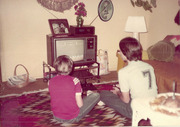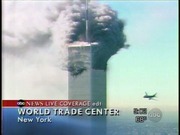tv [untitled] October 15, 2014 7:30pm-8:01pm PDT
7:30 pm
program, the fit project is our (inaudible) program and that is something that is the communication based overlay and it is positive train control system that is currently being implemented and it is designed, basically to prevent the train to train coalition and it was put in the legislatively in 2008 and so this is something that we are working on and that it will be company pleated in 2015. in the second part of the practice is the electrickfiation program and one is the electrickfiation and the second is the multiple units and i will go into both of those in details in a couple of minutes, and as a follow on to this comes the blended system that he was speaking to a few minutes ago, if you start to look at what the project description is, it is not the entire line from gill roy all the way into san francisco that will be electrified and it is the portion, basically from san jose, up to san francisco and
7:31 pm
it is a 51 mile project, and that we will go ahead and get the electrickfiation done and it runs all the way in and two tracks will be electrified and it will be an overhead contact system, and something that has been used on the east coast, and in europe, and but it is something that is going to be new to the west coast and so it is a different voltage and a different set up. and we will use the current path that we are on and that is the electrical multiple units and that is something that i have learned in more detail in a couple of minutes, the service will initially operate at 79 miles an hour with a capability to go ahead and expand to 110 miles per hour. it decreases the air possession and increases the ability to carry more riders and it basically is all positives when you look at most projects you start to see things that are
7:32 pm
negatives in different direction and this is one that i am looking for the negative and everything that i see and that i have seen in the past six months sincevy been here is all positive specifically, the emus in april, excuse me, and brief them for the process and we issued a request for information, to the car building industry and to go ahead and find out what it was that they had. we want to use something that has been an existing platform, that has been used in other parts of the world that can be adopt and that keeps you away from the challenges of something that is brand new and uses something that is proven vehicle. we had the industry come in and
7:33 pm
we had 11 different car builders that can be requested in this process and going through that, there were three of them that came in and they had the detailed discussions with us, and as a result of the other conversations our expectation, is that we will have between two and four proposers, and when we open that we take proposals some time next spring. >> what we also wanted to do, is paint the future for it, and so what it was that had been going on with cal train and show what the current situation was in the future there will be a requirement to go to 100 percent six car vehicles and ultimately length them to 8 cars and to deal with the growth and the increase and so we wanted to be sure that we
7:34 pm
are painting the picture of the car builders because we want to be sure that they understand that this will be something over time that those vehicles will grow in length and will grow in capacity >> they can apply with the requirements and we can deal with the fra requirements and so all of those regulatory pieces even with manufacturers, that currently are producing vehicles out of the country, they believe that they can comply with all of those, and will do the assembly in the u.s.. >> the floor threshold is the portion that we are going to have more detailed discussion today, what we heard from that industry, is that they are
7:35 pm
common threshold for a commuter vehicle is a bi level vehicle that has got a threshold in the 22 to 24 and the bi level vehicle by definition, will give you a higher capacity and as we move for of having that amount of capacity into the future to be able to deal with the rider ship and that is what we are targeting is the bi level, vehicle. and specifically, on the thresholds, it is an advantage to every agency to have exactly that same. and every place where you have that, it gives you a quicker boarding and a safer boarding and commonality of resource and so it is basically a positive advantage to come to a conclusion that gets to that same point. and what we currently is no level boarding at any of our stations it takes longer on the side for the passengers to go ahead and load on and off of the vehicles, we have got 8
7:36 pm
inches above type of rail and so we will have to increase that, and currently we have had that first step for our vehicles that is basically a ten inch step that then goes up into the vehicles. and whether it is a 45 inch floor height or a 25 and so there is a series of steps that go into the existing vehicles. and so, eliminating that and getting to a constant boarding height is something that will increase, that capacity, decrease the dwell time and to be able to have us carry more passengers. over the short term? the path that swre been heading on, is to go ahead and use that existing 8 inch platform and as we go forward and trying to get a vehicle that will maximize the capacity, and going to the future. and targeting that off of the they feel vehicle with a floor height that is 22, and to 24 inches. and that will be operatable with the current fleet and that is one of the issues that we happen to go forward with the
7:37 pm
basis is how you transition to whatever that future boarding height is. and of the higher that boarding height, then the more difficult that transition becomes. and not impossible, but more difficult to deal with. and as we go to the long term, there are issues that we have to deal with in terms of existing requirements. and cpuc still has a rule on the books that you can't go above a platform that is 8 inches above top of rail and that is an old rule in the books from the man on the ladder on the side of a vehicle and it is something that we need to work our way past and because what we have to do is to set the platforms back a distance and anything that is above that 8 inches, which then will put you at a point that you are in conflict with ada, the ada point is a 3 inch gap and any five 8th of an inch vertical, differential and that is one of the pieces that we have to deal with, regardless of what that ultimate warning height is resolution of that
7:38 pm
cpcu requirement. >> so as i said, it is that common desire, to go ahead and have that boarding height. and it is a matter of where that lines up. and you will hear from ben in a few minutes concerning a 50 inch platform height and we have looked and based upon what we have seen with the vehicles, has settled into that 25 inch height. but we are trying to work forward to see what we can do to reach that common goal. and when you look at the stations that are out there on cal train, there are 27 stations that we have. and there are several stations that ultimately, have to have something worked through, and but the vast majority of the stations are dedicated purely for the cal train service, but we have to fight a reasonable solution. >> specifically, as we moved forward with the emus and we have gone now and we have started an out reach process to go ahead and find out from a public what it is that they desire on board each one of the emus and we are doing it in a
7:39 pm
two part process and the first piece is really the balance between what you have for the seats and what you have for the on board bath wraoms and what you have for bike and you have the higher utilization of the bikes any place in the country, we have 80, capacity for the bikes on the other there are 48 and there is a vast desire and input from the bike community to increase those numbers, but it is a balance point for every bike that you have board, it absorbs the space that the individual be seated in plus, one space that you lose a seat as a result of having the bike on board, when you go to the bathrooms one of the current fleets has two bathrooms on board, i encourage anyone who
7:40 pm
has not gone on-line to take a survey to do that, it is 40 questions and it will take you ten minutes and this is where we are looking for what the preferences are and this survey will be opened for the 17th of october and what we are going to do is we are going to the results of that survey and we are going to temp er that to
7:41 pm
what we have heard from the industry of what they can do in the proven fleets and then come back with the recommendation, of which way and how, those vehicles could be configured. >> and then that is really our next steps, and forward, with getting the comments from the stake holders, and continued to have the technical workshops with the high speed rail and we will have another one on the 30th of this month and then the intention of after the first of next year, in the spring of going at it with an rfp and to ultimately award a vehicle contract in the late fall or early winter of 2015. and that will support the schedule that we currently have. i will take any questions. >> i am sure that we have some. >> director harper? >> i know when it comes to rail roads that the and the fra and everything, the federal government, sometimes comes in that this is it. >> and so when it comes to ada,
7:42 pm
and in which being a bus person, i am used to having to pay attention to the california ada, is that true for rail roads too or is that an indense where it is the federal ada that has to be done and california really has no discretion to or anything else? >> we have a series of conflicting requirements right now, we have the existing cpuc requirements that requires the set back in the platform and that is in direct conflict with what the fda requirements are and the federal requirements for the three inch gap and we have to go ahead and get that reconciled and get a waiver from cpuc in order to go ahead and construct those platforms, so that they will conform to the federal requirements. and fta will be providing some of the funding for the program, and the expectation, is that they will be looking for us to precisely meet that ada requirement. >> the federal requirement.
7:43 pm
>> yeah. >> and so the cpc, looks like you are anticipating you will have to say, and we will do that. >> and that is just, and we have to have the conversation with them if we have not had that conversation yet and i know that there are instances in other location wheres there has been relaxed but it is something that we have work our way through. >> director reiskin? >> the rider ship term is pretty impressive and stunning in cal trans. it is certainly i don't know a victim of its success. but i think that there is nothing to suggest if you looked at the planned bay area that that trend will reverse. and so, understanding that thinking of about the fact that we are making what is at least in our building 100 year investment, you mentioned, the goal of 6 trains per hour, and or the plan for six trains per
7:44 pm
hour, and how do you see that working if we don't achieve comment platform heights, and we have one platform at the transbay transit center. there are two or three stations on the cal train system that will be greatly linked to the high speed rail and the majority of the stations, do not have any high speed rail stops and so we are going to talk about... (inaudible) and the new downtown transit center and i think that the best for all of us is to find a way to make it. and i think that with the change to a level boarding for cal train, at the other stations will greatly enhance our capacity but as he said, the choke point will become how
7:45 pm
many trains can you get in and out of the new downtown transit center, and how does that relate to what the platform height is, and it is being driven by several stations and it is not something that is a common issue to all stations we can go to the current 75 percent, six car lengths and in future, build, and it will give us a capacity increase and it is really do you go all the way into the transbay, how much is it fourth and king, and what is that service pattern, that is part of the discussion that is ongoing. >> okay. >> so just that i understand, that i guess that it is a small number of stations but one of them is a station that connects to the airport and one of them is the high speed rail that serves downtown san francisco. >> right. >> for the latter, did i, am i interpreting correctly? that if we don't get to a
7:46 pm
common platform, height that we will not be able to achieve six trains per hour at cal train. >> we could not put a boarding height and not do something at the other stations on the line. >> so it is that trickle effect that goes all the way back through the system and what have you to do and whether you are leaving it at 8:00 or going to 24, or going to 49, a lot the of that when you look at what the rebuild requirements will be, on the other cal train stations, and it takes you to lengthening the platforms and it takes you to great separation and that there is a whole series of requirements that are behind it. >> and no, i understand that and it is a point well taken and again, we are making an investment for the next five,
7:47 pm
six, generations. and so i think that there are certainly going to be trade offs in terms of these impacts, but the building is right and as he said this is 75 billion dollars worth of investment altogether and i think that we want to make sure that we get it right and just again, i am not sure that i understand the answer to the question, if we do not have common platforms at transbay center, and the terminus in san francisco, will we be able to do six vehicles per hour with cal train. >> right now, the numbers that we have run in, and we have done a analysis that is two and we have gone up to four and we have not build a schedule that gets us to six. >> i can't answer that directly. >> okay. >> thank you. >> okay. i appreciated your slide on i
7:48 pm
guess the number of companies that you are talking to about eleven. and i am sure that out of how many of those make bi level trains that are at the 50 inch platform? >> the majority of the ones that we talked to, were at that 25 inch. >> right. >> but there are manufacturers out there that do make the trains at the 50 inch but the majority of them that are at the 50 inch are not bi level. >> okay, but there are companies that do make the bi level trains at the 50 inch. >> yeah >> so that is, and it is something that is possible. >> yes. >> great. >> thank you. >> are there any other questions or comments? >> thank you, so much. we may have further questions, but i think that we want to get to the high speed rail presentation as well. >> thank you. >> and now, mr. bench will
7:49 pm
present for high speed rail. >> good morning, directors and thank you for the opportunity to be with you today and i am ben, for the northern california regional director for the california high speed rail authority, to director reiskin point we have begun to have 50 year, and not that they feel like they take 50 years to get through, but rather that if we all were sitting here 50 years from now, what sort of system will we have wanted to have accomplished? what goals will we have wanted to achieve 50 years on? and so, from the authorities perspective and the first step, in that 50 year journey is our vehicle procurement and as you may be aware, the authority has released a request for it, and the expression of interest, and for our future vehicles. and ultimately, what we will be
7:50 pm
operating throughout california. and the reoi is being used to identify and receive the feedback for the firms requested in competing and building the trains for use on the california high speed rail system. >> we expect that the authorities order will include a face order in the neighborhood of 95 train sets. on the technical side, we are looking at a single electric multiple unit vehicle, used internationally, typical of operating in revenue service at speeds of up to 220 miles an hour and i should note that the speed of the vehicle is directly related to the boarding height, which is at the 50 inch level, and as both brian and dave pointed out.
7:53 pm
>> from the main ans perspective we need to establish a long term, and a location for a long term technical support, provision of spares, and maipt nens of those for well over 30 years, and design and construction, and operation of a heavy maipt nens facility that will allow for overhaul, and running repair and inspection, and shops and all of the support services necessary to support, the state wide system. and we will also likely have a
7:54 pm
heavy maintenance facility site somewhere in the central valley. now the request on the response of it by october 17th, and the end of next week, and the lines will be accepted after that and it is not a hard date in terms of continuing to get the expressions of interest, so the expression of interest is not a requirement to the rpf for the vehicle procurement and the firms that do not submit any of the lines and it may submit a proposal on the date that we expect to get out by the end of this year. we expect to have the rfp out by the end of the year and we don't have the firm schedule, and the authority will issue, the rfp to begin the formal
7:55 pm
procurement process, and for in firms that submit it, will be given the credential to ask the questions and participate on the one on one, and really give us an opportunity, as cal train, has done and as dave mentioned to fully vet the options for a vehicle, procurement and what the best possible vehicle would be for both state wide service, and service in the integrated corridors in northern california, and southern california, to maximize the operation of the trains, i just want to echo, both brian and daves comments and stress that we are fully committed to working with cal train and working with our partners to land on a solution that works for both commuter and high speed service, and in the corridor for san francisco and for us, between san francisco and gill roy, to maximize our ability to deliver the service
7:56 pm
and, fully integrated operation that accommodates that 50 year vision that we are trying to arrive at. and so ithink that as they have pointed out, we are in the midst of having those conversation and i think that we are off to a good start and we will be having a formal technical conversation at the end of this month and out of that, we will be able to hopefully land on several scenes that we can vet with the partner and bring to the policy boards for their consideration, with a menu of possible solutions to how we will get to that future operation, in the corridor. and so i am very confident, that we can get to that positive out come and i will be happy to answer any questions. >> and thank you. >> director? >> this is very interesting to me that see all of the different trains and heights.
7:57 pm
have any studies been done for you and cal train and the tjpa on the impacts on the operations and have you guys done any work together to just figure out how we should... >> that is really what we are in the midst of and we are having a series of technical meetings, and we will be sitting down with the high speed rail technical team will be sitting down with cal train this month, and as dave pointed out to have just that conversation. and i think in general, there is a good deal of information that we all have. these are all very well trained and experienced rail road staff, and i believe that we have all of the resources and information, available to us to make the kinds of evaluations that we are talking about here, while there may be some follow
7:58 pm
on studies we have enough information to move forward and arrive at several options for our future considerations. >> so i will ask that the get the regular report on the agencies working in particular on the impact of the operations. >> and how we are moving forward. >> i would recommend that we agenda this same topic for our next meeting, and perhaps, with a resolution for the board to consider in terms of endorsing a common boarding platform and because i think that there are benefit system wide, but just, in our roles as the board for the tjpa, and i think that we have to look out for our facility, and i think we will
7:59 pm
be significantly limiting the useful life of the utility of the facility if we end up with the different platform heights and so i would like to suggest that with the, and i guess, the rest of the board's consent that we ask the staff to draft a resolution that will be supporting that kind of a solution and also, i guess that with that, supporting the regional coordination, and the funding, and whatever impacts that it has because it will have the impacts to cal train, if not to both the high speed rail and cal train, and so we want to be cognoscente of what those impacts might be. in terms of the time lines, and it looks like you are ready to go out to rpf at the end of the year for the vehicles and cal train is following close behind and everybody has talked about the need to coordinate and negotiate and we are already coming up omid october, and at
8:00 pm
least, a small window to get this resolved and my, getting that right? that we basically, that we, all need to have this resolved, and within the next 60 days? >> i think that you are getting that right? that is part of our urgency and part of the urgency and we are trying to evaluate that the appropriate information and to be sure that we are looking at each system, and in a way that it helps to serves the operational needs and addresses it is long term needs and because we very much view both the transbay and the terminal center project, and the electrickfiation of the corridor and of the first two projects in the bay area, and we expect that the electrickfiation of the cal train is just the first step in that electrified operation and
28 Views
IN COLLECTIONS
SFGTV: San Francisco Government Television Television Archive
Television Archive  Television Archive News Search Service
Television Archive News Search Service 
Uploaded by TV Archive on

 Live Music Archive
Live Music Archive Librivox Free Audio
Librivox Free Audio Metropolitan Museum
Metropolitan Museum Cleveland Museum of Art
Cleveland Museum of Art Internet Arcade
Internet Arcade Console Living Room
Console Living Room Open Library
Open Library American Libraries
American Libraries TV News
TV News Understanding 9/11
Understanding 9/11





























